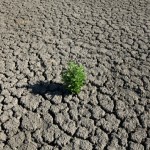The Texas Drought: How We Got Here, and Where We’re Going
The drought has meant different things for different people in Texas. For many, it meant a brown lawn and fewer trips to the car wash. For others, it meant the loss of a crop, the sale of a ranch, or the disappearance of a lake. A new report gives us the opportunity to look at some of the science behind the drought that affected every Texan, and what may lie ahead in the future.
At a meeting of the board of the Lower Colorado River Authority (LCRA) last week, Bob Rose, LCRA’s meteorologist, presented a report on the drought and his forecasts for the months ahead.
Texas had its driest year on record in 2011, he said, with an average of 14.88 inches of rain. It was also the driest the state has been in nearly a hundred years: the previous record was set in 1917 with 14.99 inches. It was also the second hottest year on record, with an average temperature of 67.2 degrees. The hottest year ever in Texas also came nearly a century ago, in 1921.
The main culprit? La Niña, a weather pattern where the surface temperatures are cooler in the Pacific, which creates drier, warmer weather in the southern U.S. (You may also know her counterpart, El Niño, which generally has the opposite effect.) La Niña sticks around for a year, sometimes longer, and tends to return once every few years. (The last La Niña was in 2007, but it was a much lighter one.)
Rose said that many models now predict that La Niña will leave completely by the end of the spring. And a weakening La Niña has been responsible for above-average rains this winter that have proved crucial in the lessening of the drought. “It’s been a nice winter,” he said. “Not exactly what I had forecasted. Much of Texas has had almost as much rain in the last 60 days as all of 2011.
Where do we go from here? Many parts of the state still need another foot or more of rain to get out of the drought. Here’s a map from the National Oceanic and Atmospheric Administration that shows how much rain different parts of Texas need to become drought-free over the next six months:
Rose said there’s no “big signal” of below normal rainfall ahead. “I don’t want to paint to rosy of a picture here, but things are improving,” he said. But Rose’s report says that there is “still no clear end in sight to the ongoing drought. However, conditions have improved some since last summer.” He expects more rains to come, and a summer “not as hot or as dry as last year.” Here’s hoping.
Read the full report:





